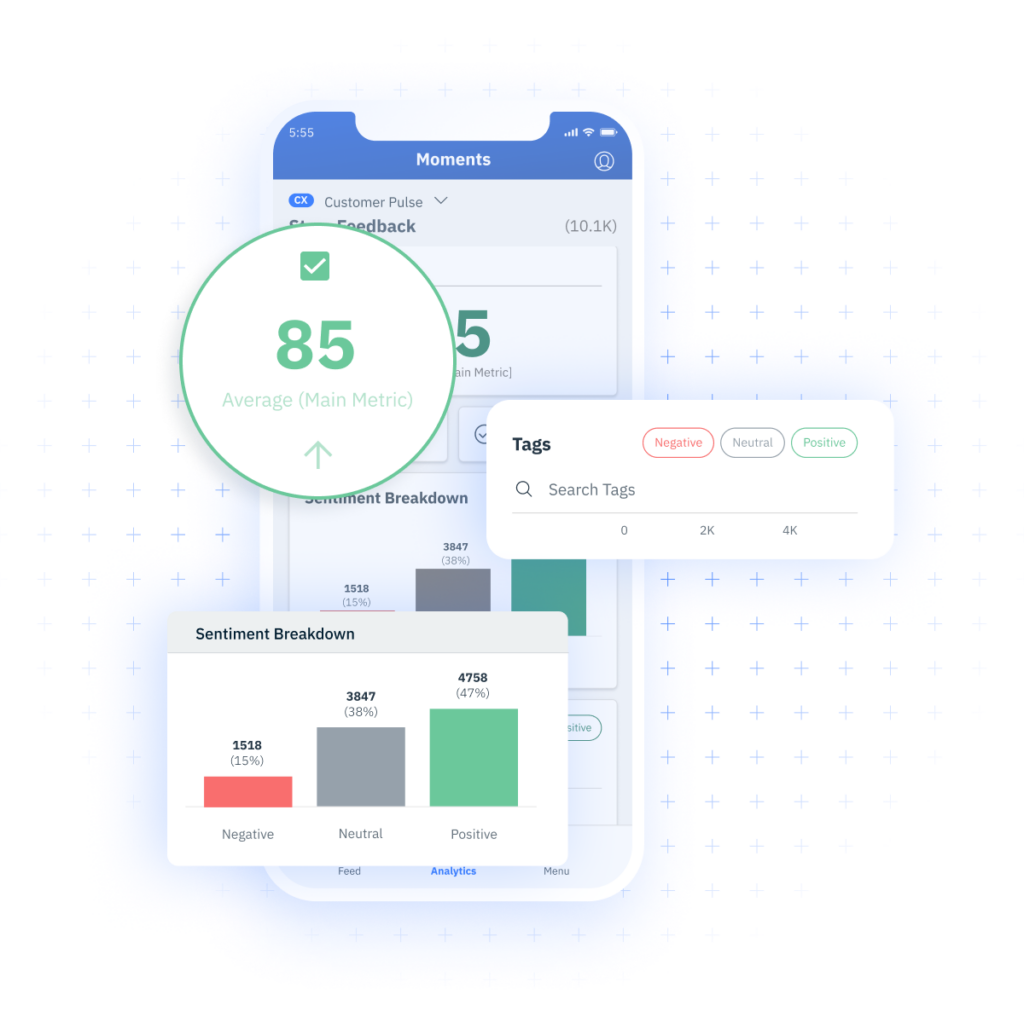Customer Sentiment: How to Measure and Improve It
Customer sentiment represents the emotions and attitudes expressed by customers towards a brand, product, or service. Improving customer sentiment will also improve customer loyalty and retention.
Understanding customer sentiment is essential for businesses trying to enhance their customer experience and drive growth. In this post, we’ll dive into what customer sentiment is, why it matters, and how you can measure and improve it to boost your business performance. But first, let’s go over a few basic definitions of customer sentiment, customer sentiment analysis, and customer sentiment score.
What is Customer Sentiment?
Customer sentiment is the emotions and attitudes expressed by customers towards a brand, product, or service. It includes both positive and negative feelings, like satisfaction, frustration, loyalty, and disappointment. By analyzing customer sentiment, businesses can gain valuable insights into how their customers perceive their offerings and overall brand experience.

Why is Customer Sentiment Important?
For customer experience leaders, customer sentiment is crucial because it directly impacts customer loyalty, satisfaction, and retention. Understanding how customers feel about your brand can help you identify strengths and areas for improvement. Positive sentiment can lead to increased customer loyalty and advocacy, while negative sentiment can signal issues that need to be addressed to prevent customer churn.
What is Customer Sentiment Analysis?
Customer sentiment analysis involves using natural language processing (NLP) and machine learning techniques to analyze customer feedback from various sources— think social media, reviews, surveys, and more. This analysis helps businesses understand the underlying emotions and attitudes expressed by customers, providing actionable insights to improve the customer experience.
What is a Customer Sentiment Score?
A customer sentiment score quantifies the overall sentiment expressed by customers towards a brand or product. This score is typically calculated by analyzing text data and assigning a numerical value to represent the sentiment, ranging from very negative to very positive. As a general rule, a high sentiment score indicates positive customer sentiment, while a low score might mean negative sentiment.
What are the Benefits of Customer Sentiment?
Understanding customer sentiment provides so many advantages for CX leaders—which ultimately lead to both strategic and operational improvements:
- Enhanced Customer Experience: By pinpointing and addressing pain points revealed through sentiment analysis, businesses can significantly elevate the overall customer experience. Insights into customer emotions and frustrations allow for targeted interventions, leading to smoother interactions and a more positive customer journey.
- Increased Customer Loyalty: Positive customer sentiment is strongly correlated with higher customer retention and loyalty. When customers feel valued and satisfied, they are more likely to stay loyal to the brand and make repeat purchases, fostering long-term relationships and reducing churn rates.
- Better Product Development: Sentiment analysis provides valuable feedback on customer preferences and pain points related to products and services. This information is important for informing product development and innovation, allowing businesses to make data-driven decisions and create offerings that better meet customer needs.
- Improved Marketing Strategies: Understanding the sentiments of your audience helps in crafting more effective marketing messages. By aligning marketing strategies with the emotions and expectations of your customers, you can create campaigns that resonate more deeply, improve engagement, and drive conversions.
- Early Issue Detection: Monitoring customer sentiment enables businesses to detect negative feedback and emerging issues early. Addressing these problems promptly can prevent them from escalating, which avoids potential damage to your brand’s reputation and maintains a positive customer relationship.
How Can Customer Sentiment Be Used to Improve the Customer Experience?
Customer sentiment can be leveraged to enhance the customer experience in several ways:
- Personalized Interactions: Use sentiment data to tailor customer interactions and provide personalized experiences.
- Proactive Support: Address negative sentiment promptly by offering proactive support and resolving issues quickly.
- Product and Service Improvements: Use insights from sentiment analysis to refine products and services based on customer feedback.
- Targeted Marketing Campaigns: Develop marketing campaigns that resonate with customer emotions and preferences.
How to Measure Customer Sentiment
Measuring customer sentiment involves many well-defined steps to accurately gauge how customers feel about your brand.
- First, collect feedback from various sources, including social media, reviews, surveys, and support interactions. This diverse data set provides a comprehensive view of customer opinions and experiences.
- Next, use NLP and sentiment analysis tools to analyze the text data. These tools help identify the emotions and attitudes expressed by customers, converting qualitative feedback into quantifiable insights.
- After analyzing the data, assign numerical values to calculate the overall customer sentiment score. This score reflects the general sentiment of your customer base, allowing you to benchmark performance and track changes over time.
- Lastly, monitor these sentiment scores consistently to identify trends and measure the impact of any changes in your business operations. Be sure to keep a close eye on sentiment trends, as you can proactively address emerging issues and continuously improve the customer experience.
How to Improve Customer Sentiment
Improving customer sentiment is an important part of building a loyal customer base and driving continual growth for your business. After you have measured and analyzed your current customer sentiment, the next step is to improve and to continue improving it. Here are steps to improve your customer sentiment:
- Identify and Analyze Pain Points
Understand your customers, including their likes and, more importantly, their dislikes. If you have already measured customer sentiment, you likely have valuable insights from customer interactions. If not, start gathering feedback through surveys, reviews, and direct conversations to understand their needs and pain points. Analyze this data to identify areas for improvement. To avoid feeling overwhelmed by the amount of data, begin by addressing the most common issues and gradually work your way down to less frequent problems. - Create a Strategy to Fix Common Pain Points
Now that you have identified your customers’ most common pain points, it’s time to develop a strategy to address these issues. Ensure you communicate these insights with your team and other relevant departments. For instance, you may need to collaborate with the customer service team to train them on handling similar inquiries or complaints or work with the IT department to improve your online checkout process. The insights you gain can also inform future improvements in product or service quality. - Offer Loyalty Programs and Incentives
As you continue to address and resolve customer pain points, consider building positive customer sentiment by offering a reward or loyalty program for repeat customers. Providing exclusive offers to loyal customers can also make them feel valued and appreciated. - Continue to Monitor and Respond to Feedback
Improving customer sentiment is an ongoing process, not a one-time effort. Continuously monitor customer feedback and reviews to gain insights into areas that need improvement. - Measure and Optimize
After implementing strategies to improve customer sentiment, measure the success of your efforts by tracking key customer experience KPIs, such as customer satisfaction scores and retention rates. Report on these improvements to gauge the effectiveness of your initiatives.
Customer Sentiment Examples and Use Cases
Here are some examples that show how some of Pearl-Plaza clients have used customer sentiment to drive significant improvements and achieve better outcomes:
Retail Industry
A leading retail brand harnessed customer sentiment data gathered from social media and online reviews to identify recurring issues and pain points. By analyzing this feedback, the retailer discovered that many customers were dissatisfied with their return policy and customer support services.
To solve this once and for all, the company revised its return policy to be more flexible and implemented enhanced training for customer support representatives. These changes led to a noticeable increase in customer satisfaction, a reduction in return-related complaints, and an overall boost in customer loyalty that supports a positive retail customer experience.
Hospitality Industry
A well-known hotel chain used customer sentiment monitoring to address areas of concern highlighted by guests. Through sentiment analysis of online reviews and survey feedback, the hotel identified recurring complaints related to cleanliness and service quality.
The insights gained prompted the hotel chain to implement stricter cleanliness protocols and enhance staff training. These improvements led to a noticeable increase in guest satisfaction scores, a rise in positive online reviews, and a stronger reputation in the hospitality industry and guest experience.

Tech Industry
A prominent software company leveraged sentiment analysis to collect and evaluate feedback on newly launched features. By examining user sentiment, the company was able to determine which features were well-received and which were causing frustration. This analysis guided their product development team in prioritizing updates and enhancements that aligned with customer preferences. As a result, the company improved its software product, increased user satisfaction, and strengthened its competitive edge in the market.
Improve Your Customer Sentiment with Pearl-Plaza

At Pearl-Plaza, we specialize in helping businesses understand and improve customer sentiment. Our comprehensive CX solutions and expert team can help you analyze customer feedback, gain valuable insights, and implement strategies to enhance your customer experience. Using our Case Management feature, we can help you reach out to customers with negative sentiment, to try and recover those relationships while you still can. Schedule a demo to learn more.






